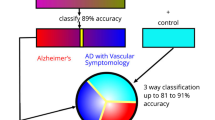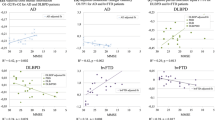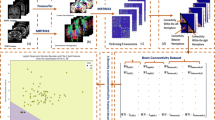Abstract
Diagnosis of Alzheimer’s disease (AD) from AD with cerebrovascular disease pathology (AD-CVD) is a rising challenge. Using electrovestibulography (EVestG) measured signals, we develop an automated feature extraction and selection algorithm for an unbiased identification of AD and AD-CVD from healthy controls as well as their separation from each other. EVestG signals of 24 healthy controls, 16 individuals with AD, and 13 with AD-CVD were analyzed within two separate groupings: One-versus-One and One-versus-All. A multistage feature selection process was conducted over the training dataset using linear support vector machine (SVM) classification with 10-fold cross-validation, k nearest neighbors/averaging imputation, and exhaustive search. The most frequently selected features that achieved highest classification performance were selected. 10-fold cross-validation was applied via a linear SVM classification on the entire dataset. Multivariate analysis was run to test the between population differences while controlling for the covariates. Classification accuracies of ≥ 80% and 78% were achieved for the One-versus-All classification approach and AD versus AD-CVD separation, respectively. The results also held true after controlling for the effect of covariates. AD/AD-CVD participants showed smaller/larger EVestG averaged field potential signals compared to healthy controls and AD-CVD/AD participants. These characteristics are in line with our previous study results.
Graphical abstract






Similar content being viewed by others
References
Elahi FM, Miller BL (2017) A clinicopathological approach to the diagnosis of dementia. Nat Rev Neurol 13:457–477. https://doi.org/10.1038/nrneurol.2017.96
McKhann GM, Knopman DS, Chertkow H et al (2011) The diagnosis of dementia due to Alzheimer’s disease: recommendations from the National Institute on Aging-Alzheimer’s Association workgroups on diagnostic guidelines for Alzheimer’s disease. Alzheimers Dement 7:263–269. https://doi.org/10.1016/j.jalz.2011.03.005
Turner RS, Stubbs T, Davies DA, Albensi BC (2020) Potential new approaches for diagnosis of Alzheimer’s disease and related dementias. Front Neurol 11:496. https://doi.org/10.3389/fneur.2020.00496
Jack CR, Bennett DA, Blennow K et al (2018) NIA-AA Research Framework: toward a biological definition of Alzheimer’s disease. Alzheimer’s & Dementia 14:535–562. https://doi.org/10.1016/j.jalz.2018.02.018
Wilczyńska K, Waszkiewicz N (2020) Diagnostic utility of selected serum dementia biomarkers: amyloid β-40, amyloid β-42, Tau protein, and YKL-40: a review. J Clin Med 9:3452. https://doi.org/10.3390/jcm9113452
Zhang J, Jia J, Qin W, Wang S (2013) Combination of plasma tumor necrosis factor receptors signaling proteins, beta-amyloid and apolipoprotein E for the detection of Alzheimer’s disease. Neurosci Lett 541:99–104. https://doi.org/10.1016/j.neulet.2013.03.007
Tang S-C, Yang K-C, Chen C-H et al (2018) Plasma β-amyloids and Tau proteins in patients with vascular cognitive impairment. Neuromolecular Med 20:498–503. https://doi.org/10.1007/s12017-018-8513-y
Krishnan S, Rani P (2014) Evaluation of selenium, redox status and their association with plasma amyloid/tau in Alzheimer’s disease. Biol Trace Elem Res 158:158–165. https://doi.org/10.1007/s12011-014-9930-x
Qian W, Schweizer T, Munoz D, Fischer CE (2016) Misdiagnosis of Alzheimer’s disease: inconsistencies between clinical diagnosis and neuropathological confirmation. Alzheimer’s & Dementia 12:P293–P293. https://doi.org/10.1016/j.jalz.2016.06.529
Beach TG, Monsell SE, Phillips LE, Kukull W (2012) Accuracy of the clinical diagnosis of Alzheimer disease at National Institute on Aging Alzheimer Disease Centers, 2005–2010. J Neuropathol Exp Neurol 71:266–273. https://doi.org/10.1097/NEN.0b013e31824b211b
Rizzi L, Rosset I, Roriz-Cruz M (2014) Global epidemiology of dementia: Alzheimer’s and vascular types. Biomed Res Int 2014:908915. https://doi.org/10.1155/2014/908915
Mattson MP (2000) Apoptosis in neurodegenerative disorders. Nat Rev Mol Cell Biol 1:120–130. https://doi.org/10.1038/35040009
Iadecola C (2013) The pathobiology of vascular dementia. Neuron 80:844–66. https://doi.org/10.1016/j.neuron.2013.10.008
Custodio N, Montesinos R, Lira D et al (2017) Mixed dementia: a review of the evidence. Dement Neuropsychol 11:364–370. https://doi.org/10.1590/1980-57642016dn11-040005
Hachinski VC, Iliff LD, Zilhka E et al (1975) Cerebral blood flow in dementia. Arch Neurol 32:632–637. https://doi.org/10.1001/archneur.1975.00490510088009
Molsa PK, Paljarvi L, Rinne JO et al (1985) Validity of clinical diagnosis in dementia: a prospective clinicopathological study. J Neurol Neurosurg Psychiatry 48:1085–1090. https://doi.org/10.1136/jnnp.48.11.1085
Román GC, Tatemichi TK, Erkinjuntti T et al (1993) Vascular dementia: diagnostic criteria for research studies. Report of the NINDS-AIREN International Workshop. Neurol 43:250–260. https://doi.org/10.1212/wnl.43.2.250
Gold G, Giannakopoulos P, Montes-Paixao C et al (1997) Sensitivity and specificity of newly proposed clinical criteria for possible vascular dementia. Neurology 49:690–694. https://doi.org/10.1212/WNL.49.3.690
Lithgow B (2012) A methodology for detecting field potentials from the external ear canal: NEER and EVestG. Ann Biomed Eng 40:1835–1850. https://doi.org/10.1007/s10439-012-0526-3
Blakley B, Suleiman A, Rutherford G et al (2019) EVestG recordings are vestibuloacoustic signals. J Med Biol Eng 39:213–217. https://doi.org/10.1007/s40846-018-0398-6
Moussavi Z, Suleiman A, Rutherford G, et al (2019) A pilot randomised double-blind study of the tolerability and efficacy of repetitive transcranial magnetic stimulation on persistent post-concussion syndrome. Sci Rep 9:. https://doi.org/10.1038/s41598-019-41923-6
Suleiman A, Lithgow B, Dastgheib Z, et al (2017) Quantitative measurement of post-concussion syndrome using electrovestibulography. Sci Rep 7:. https://doi.org/10.1038/s41598-017-15487-2
Suleiman A, Lithgow B, Mansouri B, Moussavi Z (2018) Investigating the validity and reliability of electrovestibulography (EVestG) for detecting post-concussion syndrome (PCS) with and without comorbid depression. Sci Rep 8:. https://doi.org/10.1038/s41598-018-32808-1
Lithgow BJ, Shoushtarian M (2015) Parkinson’s disease: disturbed vestibular function and levodopa. J Neurol Sci 353:49–58. https://doi.org/10.1016/j.jns.2015.03.050
Dastgheib ZA, Lithgow B, Moussavi Z (2012) Diagnosis of Parkinson’s disease using electrovestibulography. Med Biol Eng Comput 50:483–491. https://doi.org/10.1007/s11517-012-0890-z
Dastgheib ZA, Lithgow B, Blakely B, Moussavi Z (2016) Application of vestibular spontaneous response as a diagnostic aid for Meniere’s disease. Ann Biomed Eng 44:1672–1684. https://doi.org/10.1007/s10439-015-1441-1
Dastgheib ZA, Lithgow B, Blakley B, Moussavi Z (2015) A new diagnostic vestibular evoked response. J Otolaryngol Head Neck Surg 44:14. https://doi.org/10.1186/s40463-015-0065-7
Blakley B, Dastgheib ZA, Lithgow B, Moussavi Z (2014) Preliminary report: neural firing patterns specific for Meniere’s disease. J Otolaryngol Head Neck Surg 43:52. https://doi.org/10.1186/s40463-014-0052-4
Lithgow BJ, Garrett AL, Moussavi ZM et al (2015) Major depression and electrovestibulography. World J Biol Psychiatry 16:334–350. https://doi.org/10.3109/15622975.2015.1014410
Lithgow B, Moussavi Z, Fitzgerald P (2019) Quantitative separation of the depressive phase of bipolar disorder and major depressive disorder using electrovestibulography. The World Journal of Biological Psychiatry 20:1–35. https://doi.org/10.1080/15622975.2019.1599143
Lithgow BJ, Moussavi Z, Gurvich C et al (2019) Bipolar disorder in the balance. Eur Arch Psychiatry Clin Neurosci 269:761–775. https://doi.org/10.1007/s00406-018-0935-x
Wei EX, Oh ES, Harun A et al (2019) Increased prevalence of vestibular loss in mild cognitive impairment and Alzheimer’s disease. Curr Alzheimer Res 16:1143–1150. https://doi.org/10.2174/1567205016666190816114838
Dieterich M, Bense S, Stephan T et al (2003) fMRI signal increases and decreases in cortical areas during small-field optokinetic stimulation and central fixation. Exp Brain Res 148:117–127. https://doi.org/10.1007/s00221-002-1267-6
Vitte E, Derosier C, Caritu Y et al (1996) Activation of the hippocampal formation by vestibular stimulation: a functional magnetic resonance imaging study. Exp Brain Res 112:523–526. https://doi.org/10.1007/BF00227958
Seo YJ, Kim J, Kim SH (2016) The change of hippocampal volume and its relevance with inner ear function in Meniere’s disease patients. Auris Nasus Larynx 43:620–625. https://doi.org/10.1016/j.anl.2016.01.006
Brandt T, Schautzer F, Hamilton DA et al (2005) Vestibular loss causes hippocampal atrophy and impaired spatial memory in humans. Brain 128:2732–2741. https://doi.org/10.1093/brain/awh617
Lithgow BJ, Dastgheib Z, Anssari N et al (2021) Physiological separation of Alzheimer’s disease and Alzheimer’s disease with significant levels of cerebrovascular symptomology and healthy controls. Med Biol Eng Comput 59:1597–1610. https://doi.org/10.1007/s11517-021-02409-8
Jones TA, Jones SM (1999) Short latency compound action potentials from mammalian gravity receptor organs. Hear Res 136:75–85. https://doi.org/10.1016/s0378-5955(99)00110-0
Brown DJ, Patuzzi RB (2010) Evidence that the compound action potential (CAP) from the auditory nerve is a stationary potential generated across dura mater. Hear Res 267:12–26. https://doi.org/10.1016/j.heares.2010.03.091
Møller AR (1983) On the origin of the compound action potentials (N1, N2) of the cochlea of the rat. Exp Neurol 80:633–644. https://doi.org/10.1016/0014-4886(83)90313-8
Xu D-E, Zhang W-M, Yang ZZ et al (2014) Amyloid precursor protein at node of Ranvier modulates nodal formation. Cell Adh Migr 8:396–403. https://doi.org/10.4161/cam.28802
Liu C, Tan FCK, Xiao Z-C, Dawe GS (2015) Amyloid precursor protein enhances Nav1.6 sodium channel cell surface expression. J Biol Chem 290:12048–12057. https://doi.org/10.1074/jbc.M114.617092
Mayordomo-Cava J, Yajeya J, Navarro-López JD, Jiménez-Díaz L (2015) Amyloid-β (25–35) modulates the expression of GirK and KCNQ channel genes in the hippocampus. PLoS ONE 10:e0134385. https://doi.org/10.1371/journal.pone.0134385
DeTure MA, Dickson DW (2019) The neuropathological diagnosis of Alzheimer’s disease. Mol Neurodegener 14:32. https://doi.org/10.1186/s13024-019-0333-5
Guyon I, Elisseeff A (2003) An introduction of variable and feature selection. J Machine Learning Research Special Issue on Variable and Feature Selection 3:1157–1182. https://doi.org/10.1162/153244303322753616
Hastie T, Tibshirani R, Friedman J (2009) The elements of statistical learning: data mining, inference, and prediction, Second Edition. Springer Science & Business Media
Nasreddine ZS, Phillips NA, Bédirian V et al (2005) The Montreal Cognitive Assessment, MoCA: a brief screening tool for mild cognitive impairment. J Am Geriatr Soc 53:695–699. https://doi.org/10.1111/j.1532-5415.2005.53221.x
Montgomery SA, Åsberg M (1979) A new depression scale designed to be sensitive to change. Br J Psychiatry 134:382–389. https://doi.org/10.1192/bjp.134.4.382
Dastgheib, Zeinab (2016) The use of spontaneous vestibular response for diagnosis of Meniere’s disease. Ph.D. dissertation, Biomedical Engineering Program, Dept. Elec. & Comp. Engineering, University of Manitoba
Kumaragamage C, Lithgow B, Moussavi Z (2015) A new low-noise signal acquisition protocol and electrode placement for electrocochleography (ECOG) recordings. Med Biol Eng Comput 53:499–509. https://doi.org/10.1007/s11517-015-1251-5
Dolan DF, Xi L, Nuttall AL (1989) Characterization of an EPSP-like potential recorded remotely from the round window. J Acoust Soc Am 86:2167–2171. https://doi.org/10.1121/1.398477
van Emst MG, Klis SFL, Smoorenburg GF (1996) 4-Aminopyridine effects on summating potentials in the guinea pig. Hear Res 102:70–80. https://doi.org/10.1016/S0378-5955(96)00149-9
Wilcoxon F (1945) Individual comparisons by ranking methods. Biometrics Bulletin 1:80–83. https://doi.org/10.2307/3001968
Kalpić D, Hlupić N, Lovrić M (2011) Student’s t-tests. In: Lovric M (ed) International Encyclopedia of Statistical Science. Springer, Berlin, Heidelberg, pp 1559–1563
James G, Witten D, Hastie T, Tibshirani R (2014) An introduction to statistical learning: with applications in R. Springer Publishing Company, Incorporated
Elwali A, Moussavi Z (2021) A feature reduction and selection algorithm for improved obstructive sleep apnea classification process. Med Biol Eng Comput. https://doi.org/10.1007/s11517-021-02421-y
Contet C, Goulding SP, Kuljis DA, Barth AL (2016) BK channels in the central nervous system. Int Rev Neurobiol 128:281–342. https://doi.org/10.1016/bs.irn.2016.04.001
Gutzmann JJ, Lin L, Hoffman DA (2019) Functional coupling of Cav23 and BK potassium channels regulates action potential repolarization and short-term plasticity in the mouse hippocampus. Front Cell Neurosci 13:27. https://doi.org/10.3389/fncel.2019.00027
Kshatri AS, Gonzalez-Hernandez A, Giraldez T (2018) Physiological roles and therapeutic potential of Ca2+ activated potassium channels in the nervous system. Front Mol Neurosci 11:258. https://doi.org/10.3389/fnmol.2018.00258
de Moraes Marchiori LL, de Almeida Rego Filho E, Matsuo T (2006) Hypertension as a factor associated with hearing loss. Braz J Otorhinolaryngol 72:533–540. https://doi.org/10.1016/s1808-8694(15)31001-6
Zeigelboim BS, Jurkiewicz AL, Klagenberg KF, et al (2006) Vestibular evaluation in patients with systemic arterial hypertension: a preliminary study. http://arquivosdeorl.org.br/additional/acervo_eng.asp?Id=381. Accessed 14 Oct 2020
Maia CAS, de Campos CAH (2005) Diabetes mellitus as etiological factor of hearing loss. Braz J Otorhinolaryngol 71:208–214. https://doi.org/10.1016/S1808-8694(15)31312-4
M.D DA Neuropathology. https://neuropathology-web.org/chapter6/chapter6aMs.html. Accessed 19 Oct 2020
Huxley AF (1959) Ion movements during nerve activity. Ann N Y Acad Sci 81:221–246. https://doi.org/10.1111/j.1749-6632.1959.tb49311.x
Hodgkin AL, Huxley AF (1952) The components of membrane conductance in the giant axon of Loligo. J Physiol 116:473–496
Hodgkin AL, Huxley AF (1952) A quantitative description of membrane current and its application to conduction and excitation in nerve. J Physiol 117:500–544
Funding
This study was supported by MITACS (IT25603) in partnership with the Riverview Health Center Foundation.
Author information
Authors and Affiliations
Contributions
Z. D contributed to data acquisition, data and statistical analysis and writing the paper. B. L. and Z. M. supervised the entire project and contributed to the writing of the paper and discussion of the results. All authors reviewed and approved the final manuscript.
Corresponding author
Ethics declarations
Conflict of interest
The author Brian Lithgow has less than 0.5% shares in company NeuralDX Pty. Ltd. No other authors have any conflict of interest.
Additional information
Publisher's Note
Springer Nature remains neutral with regard to jurisdictional claims in published maps and institutional affiliations.
Supplementary Information
Below is the link to the electronic supplementary material.
Rights and permissions
About this article
Cite this article
Dastgheib, Z.A., Lithgow, B.J. & Moussavi, Z.K. An unbiased algorithm for objective separation of Alzheimer’s, Alzheimer’s mixed with cerebrovascular symptomology, and healthy controls from one another using electrovestibulography (EVestG). Med Biol Eng Comput 60, 797–810 (2022). https://doi.org/10.1007/s11517-022-02507-1
Received:
Accepted:
Published:
Issue Date:
DOI: https://doi.org/10.1007/s11517-022-02507-1




